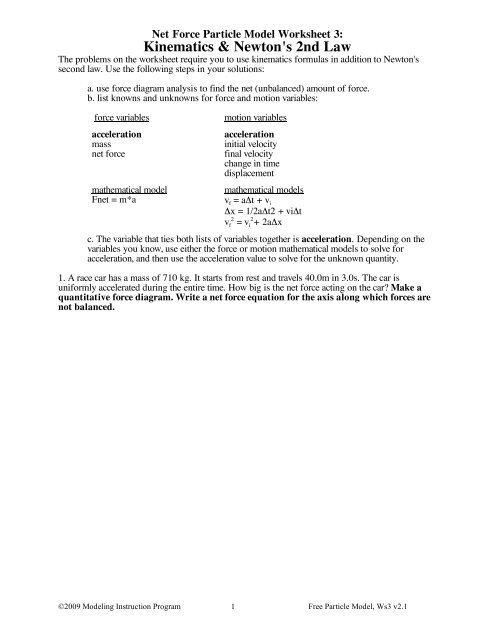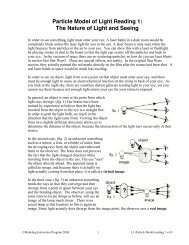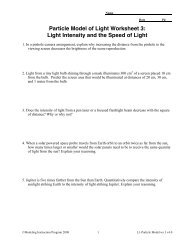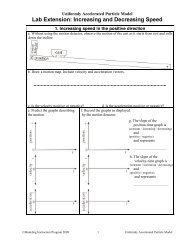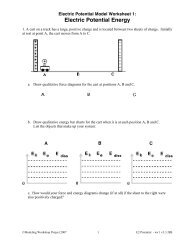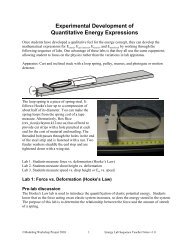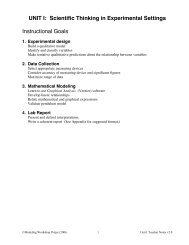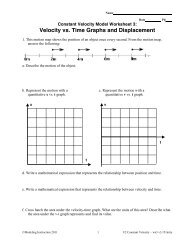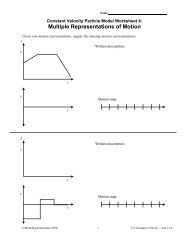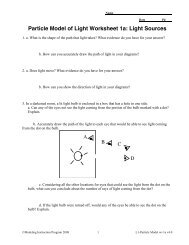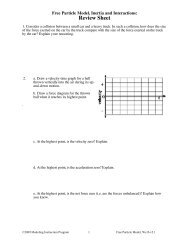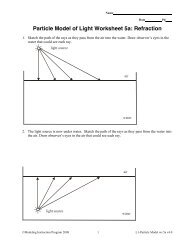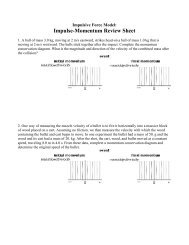Worksheet 3 - Modeling Physics
Worksheet 3 - Modeling Physics
Worksheet 3 - Modeling Physics
You also want an ePaper? Increase the reach of your titles
YUMPU automatically turns print PDFs into web optimized ePapers that Google loves.
Net Force Particle Model <strong>Worksheet</strong> 3:<br />
Kinematics & Newton's 2nd Law<br />
The problems on the worksheet require you to use kinematics formulas in addition to Newton's<br />
second law. Use the following steps in your solutions:<br />
a. use force diagram analysis to find the net (unbalanced) amount of force.<br />
b. list knowns and unknowns for force and motion variables:<br />
force variables<br />
acceleration<br />
mass<br />
net force<br />
mathematical model<br />
Fnet = m*a<br />
motion variables<br />
acceleration<br />
initial velocity<br />
final velocity<br />
change in time<br />
displacement<br />
mathematical models<br />
v f = aΔt + v i<br />
Δx = 1/2aΔt2 + viΔt<br />
v f 2 = v i 2 + 2aΔx<br />
c. The variable that ties both lists of variables together is acceleration. Depending on the<br />
variables you know, use either the force or motion mathematical models to solve for<br />
acceleration, and then use the acceleration value to solve for the unknown quantity.<br />
1. A race car has a mass of 710 kg. It starts from rest and travels 40.0m in 3.0s. The car is<br />
uniformly accelerated during the entire time. How big is the net force acting on the car Make a<br />
quantitative force diagram. Write a net force equation for the axis along which forces are<br />
not balanced.<br />
<br />
<br />
<br />
<br />
<br />
©2009 <strong>Modeling</strong> Instruction Program 1 Free Particle Model, Ws3 v2.1
2. Suppose that a 1000 kg car is traveling at 25 m/s (55 mph). Its brakes can apply a force of<br />
5000N. What is the minimum distance required for the car to stop Make a quantitative force<br />
diagram. Write a net force equation for the axis along which forces are not balanced.<br />
<br />
<br />
<br />
<br />
<br />
3. A 65 kg person dives into the water from the 10 m platform.<br />
a. What is her speed as she enters the water<br />
b. She comes to a stop 2.0 m below the surface of the water. Find the force on the swimmer<br />
by the water. <br />
©2009 <strong>Modeling</strong> Instruction Program 2 Free Particle Model, Ws3 v2.1
4. During a head-on collision, a passenger in the front seat of a car accelerates from 13.3 m/s ( 30<br />
miles/hour) to rest in 0.10 s.<br />
a. Calculate the acceleration of the passenger.<br />
b. The driver of the car holds out his arm to keep his 25 kg child (who is not wearing a seat<br />
belt) from smashing into the dashboard. How much force must he exert on the child<br />
c. What is the weight of the child<br />
d. Convert the forces in parts b and c from Newtons to pounds. 1 lb = 4.45N. What are the<br />
chances the driver will be able to stop the child<br />
©2009 <strong>Modeling</strong> Instruction Program 3 Free Particle Model, Ws3 v2.1


